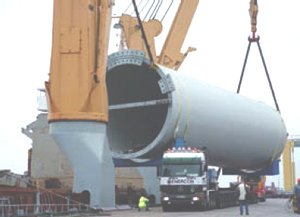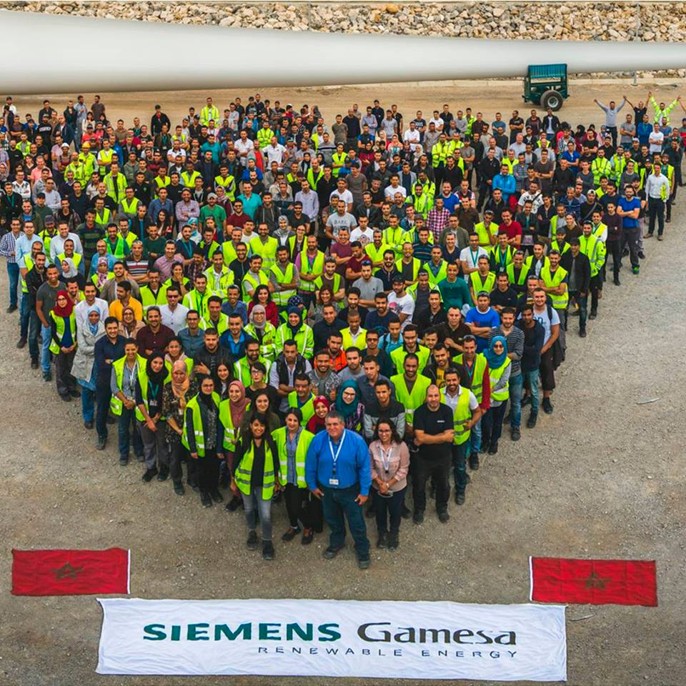To take advantage of its technological advance, the European wind industry focuses on offshore wind. Although challenging from a technical standpoint and even if not applicable to every EU country, this option enables large developers to overcome most onshore land limitations. Since the industry thrived on subsidized premium prices paid for wind electricity in Europe, costlier offshore wind options provide justifications for sustaining high prices.
 Due to high costs of offshore wind turbine foundations, current research in European wind turbine designs seek to build larger, more efficient machines. As the power of a wind turbine is multiplied by four when doubling its rotor diameter, added productivity can be obtained. The same applies to onshore conditions, where reducing the amount of wind turbines lowers maintenance costs. This issue is far more critical in offshore settings, as wind turbines are more difficult to access while operating in corrosive marine environments.
Due to high costs of offshore wind turbine foundations, current research in European wind turbine designs seek to build larger, more efficient machines. As the power of a wind turbine is multiplied by four when doubling its rotor diameter, added productivity can be obtained. The same applies to onshore conditions, where reducing the amount of wind turbines lowers maintenance costs. This issue is far more critical in offshore settings, as wind turbines are more difficult to access while operating in corrosive marine environments.
Although off-shore wind costs are dropping, neither wind turbines exports nor their integration to meet the developing world's increasing energy needs are effectively met. Indeed, with Europe's slowing wind markets at 238 GW onshore + 34 GW offshore installed capacity, less than a quarter of the world's 1 021 GW (over 1 TW) wind capacity remained on EU-grounds in 2023 (source: GWEC, WWEA).
As Europe's current 34 GW offshore wind capacity becomes more cost-efficient, most onshore wind turbine markets shifted to the USA's 150 GW and China’s staggering 403 GW (+37 GW offshore) of installed capacities. From the year 2010 China became the global wind energy leader, by fielding close to 50% of the world's yearly market.
Complementary to their US and Asia expansions, wind industry transfers from Denmark, Germany, and Spain underlined the relevance of accessing Atlantic trade winds. Regionally integrated wind industries will support North Africa's economic growth. Leveraging offshore technology developments to on-shore wind turbines, the Sahara Wind project's scale induces technology transfers that will facilitate the expansion of wind energy in developing countries.
 Based on the initial transfer of a wind blade manufacturing plant (80% dedicated to export, prior to plant shut down), production and maintenance costs have dropped. When deployed in excellent wind regions, local wind turbine manufacturing makes wind electricity far more competitive. A much larger Aeolon wind blade factory is for that matter being built.
Based on the initial transfer of a wind blade manufacturing plant (80% dedicated to export, prior to plant shut down), production and maintenance costs have dropped. When deployed in excellent wind regions, local wind turbine manufacturing makes wind electricity far more competitive. A much larger Aeolon wind blade factory is for that matter being built.
Enhanced electricity access substantially boosts economic prospects of rather desolate desert areas. Within today's tumultuous context, such an inclusive energy access is an environmental asset to both Africa and Europe.
Since wind turbines represent the bulk of the Sahara Wind project's investment, with 20% remaining for the HVDC line, electricity is generated at very low costs. This opens a variety of local energy-intensive applications, contributing to a sound operational balancing of any transmission infrastructure. Several projects of the size of Sahara Wind's (10-GW Wind Farms connected to HVDC lines) are already operational in China. With the growing sizes of projects, good precedents have been set for the transfer of wind turbine manufacturing. These can help address the rising electricity needs of emerging economies.



